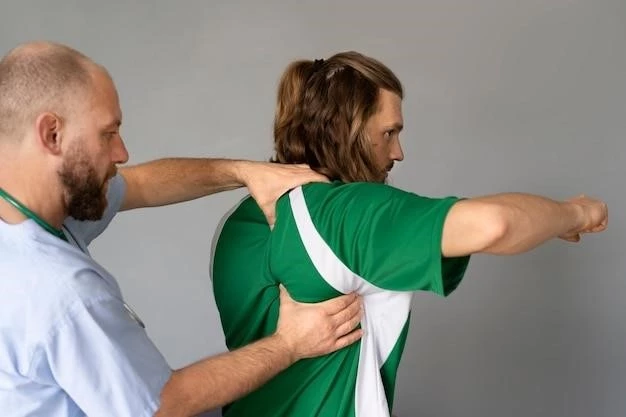Disease ─ High Scapula
I․ Introduction
Welcome to the comprehensive guide on the condition known as high scapula․ This article aims to provide a detailed overview of the anatomical structure of the scapula, the causes, symptoms, diagnosis, treatment options, rehabilitation techniques, and the prognosis associated with excessive scapular height․ High scapula, also referred to as scapular winging or winged scapula, is a condition where the scapula protrudes prominently from the back, leading to pain, weakness, and limited range of motion in the shoulder and upper back region․
Understanding the underlying reasons for high scapula is crucial for effective management and treatment․ Various factors can contribute to this malady, including nerve damage, muscle weakness, trauma, or certain medical conditions․ By delving into the specifics of high scapula, healthcare professionals can diagnose and implement tailored treatment plans to address the root cause and alleviate symptoms․
Throughout this article, we will explore the intricate details of high scapula, shedding light on both the anatomical complexities and the implications of this condition on a patient’s daily life․ By elucidating the nuances of high scapula, we aim to equip readers with valuable insights into recognizing, diagnosing, and managing this often-overlooked musculoskeletal issue․
II․ Anatomy of the Scapula
The scapula, commonly known as the shoulder blade, is a key bone in the human shoulder complex․ It is a triangular-shaped flat bone situated on the posterior side of the thorax and plays a crucial role in shoulder movement and stability․ Understanding the intricate anatomy of the scapula is essential for comprehending conditions like high scapula․
The scapula consists of three borders – superior, medial, and lateral, and three angles – superior, inferior, and lateral․ The prominent features of the scapula include the acromion process, coracoid process, glenoid cavity, spine of the scapula, and the supraspinous and infraspinous fossae․
The acromion process forms the roof of the shoulder joint and articulates with the clavicle, providing stability and a range of motion to the shoulder․ The coracoid process serves as an attachment site for various muscles and ligaments, contributing to shoulder movement․ The glenoid cavity is a shallow socket where the head of the humerus articulates, forming the shoulder joint․
The spine of the scapula divides the posterior surface into the supraspinous and infraspinous fossae, which house important muscles responsible for shoulder movement and stability․ Understanding the nuanced anatomy of the scapula lays the foundation for diagnosing and treating conditions like high scapula, ensuring optimal patient care․
III․ Understanding High Scapula
High scapula, also referred to as scapular winging, is a condition characterized by the abnormal protrusion or prominence of the scapula from the back․ This condition can lead to a range of symptoms, including shoulder pain, weakness, limited range of motion, and cosmetic concerns․
High scapula is often caused by dysfunction or weakness in the muscles that stabilize the scapula against the thoracic wall․ Nerve damage or compression, trauma, muscle imbalances, or underlying medical conditions can contribute to the development of high scapula․ Proper diagnosis and understanding of the specific factors causing high scapula are crucial for effective treatment․
Patients with high scapula may experience difficulty performing everyday activities that involve shoulder movement, such as overhead reaching, lifting objects, or participating in sports․ The aesthetic impact of a visibly protruding scapula can also significantly affect an individual’s self-image and quality of life․
Through a comprehensive understanding of the pathophysiology and biomechanics of high scapula, healthcare professionals can tailor treatment plans to address the root cause of the condition, alleviate symptoms, and improve functional outcomes for affected individuals․ Rehabilitation strategies focused on strengthening the stabilizing muscles and restoring proper scapular mechanics play a vital role in managing high scapula․
IV․ Diagnosis
Diagnosing high scapula involves a comprehensive assessment by a healthcare provider, often starting with a thorough physical examination․ During the examination, the clinician will observe the position of the scapula at rest and during various movements of the shoulder and arm to assess for any abnormal protrusion or winging․
Imaging studies such as X-rays, magnetic resonance imaging (MRI), or computed tomography (CT) scans may be utilized to visualize the bony and soft tissue structures around the scapula, allowing for a more detailed assessment of the underlying anatomy and any potential abnormalities contributing to the high scapula․
Electromyography (EMG) and nerve conduction studies may be employed to evaluate the function of the nerves and muscles surrounding the scapula․ These tests can help identify any nerve damage or muscle weakness that could be contributing to the scapular winging․
In some cases, additional diagnostic procedures such as ultrasound or nerve blocks may be recommended to further elucidate the specific factors causing high scapula․ A multidisciplinary approach involving orthopedic specialists, neurologists, and physical therapists may be necessary to ensure a comprehensive and accurate diagnosis of high scapula․
V․ Treatment Options
Managing high scapula involves a multidimensional approach aimed at addressing the underlying causes and improving functional outcomes for individuals affected by this condition․ Treatment options for high scapula may vary based on the severity of symptoms, the underlying pathology, and the individual patient’s needs․
Non-surgical interventions such as physical therapy, targeted exercises to strengthen the scapular stabilizing muscles, and postural correction techniques are often recommended as initial treatment modalities for high scapula․ These interventions focus on improving scapular mechanics, enhancing shoulder stability, and minimizing pain and discomfort․
In cases where conservative measures do not provide adequate relief or if there is a significant structural abnormality contributing to the high scapula, surgical intervention may be considered․ Surgical procedures for high scapula may involve stabilizing the scapula through tendon transfers, muscle reattachments, or other corrective techniques to restore proper scapular function․

Postoperative rehabilitation, including physical therapy and gradual return to activities, plays a crucial role in optimizing surgical outcomes and restoring functionality in individuals undergoing surgical treatment for high scapula․ Close monitoring by healthcare professionals is essential throughout the treatment process to ensure optimal recovery and long-term success;
VI․ Rehabilitation and Management
Rehabilitation and management strategies play a pivotal role in the comprehensive care of individuals with high scapula․ A tailored rehabilitation program focusing on strengthening the scapular stabilizing muscles, improving shoulder mobility, and correcting postural imbalances is essential for optimizing functional outcomes and reducing symptoms associated with high scapula․
Physical therapy interventions, including specific exercises targeting the scapular retractors, elevators, and depressors, can help restore proper muscle balance and coordination around the scapula․ Range of motion exercises and stretching techniques aim to enhance flexibility in the shoulder joint and surrounding tissues, promoting optimal movement patterns․
Postural re-education is often a key component of rehabilitation for high scapula, emphasizing proper alignment and positioning of the scapula to prevent excessive protrusion and improve overall shoulder mechanics․ Addressing contributing factors such as muscle weakness, nerve dysfunction, or biomechanical abnormalities through targeted interventions can enhance the effectiveness of rehabilitation efforts․
Long-term management strategies for high scapula may involve ongoing physical therapy, periodic monitoring of symptoms, and adjustments to the treatment plan as needed to maintain optimal shoulder function and minimize the risk of recurrence․ By fostering collaboration between patients, healthcare providers, and rehabilitation specialists, successful management of high scapula can be achieved, enabling individuals to regain functionality and improve their quality of life․
VII․ Prognosis and Conclusion
The prognosis for individuals with high scapula is generally favorable with appropriate diagnosis, treatment, and rehabilitation efforts․ By addressing the underlying causes of scapular winging and implementing a tailored management plan, patients can experience significant improvements in shoulder function, pain reduction, and overall quality of life․
Non-surgical interventions, such as physical therapy and targeted exercises, can yield positive outcomes for many individuals with high scapula, particularly when initiated early and followed consistently․ Patients who require surgical intervention typically have successful outcomes, with restored scapular stability and improved shoulder mechanics․
Rehabilitation and management strategies play a crucial role in the long-term prognosis of high scapula, providing ongoing support and guidance to individuals as they progress through treatment and recovery․ By adhering to a comprehensive rehabilitation program and adopting healthy lifestyle habits, patients can optimize their shoulder function and minimize the risk of recurrent symptoms․
In conclusion, high scapula, though often challenging, is a manageable condition with the right interventions and a multidisciplinary approach․ By fostering collaboration between healthcare providers, rehabilitation specialists, and patients, successful outcomes can be achieved, allowing individuals with high scapula to regain function, alleviate symptoms, and enhance their overall well-being․
